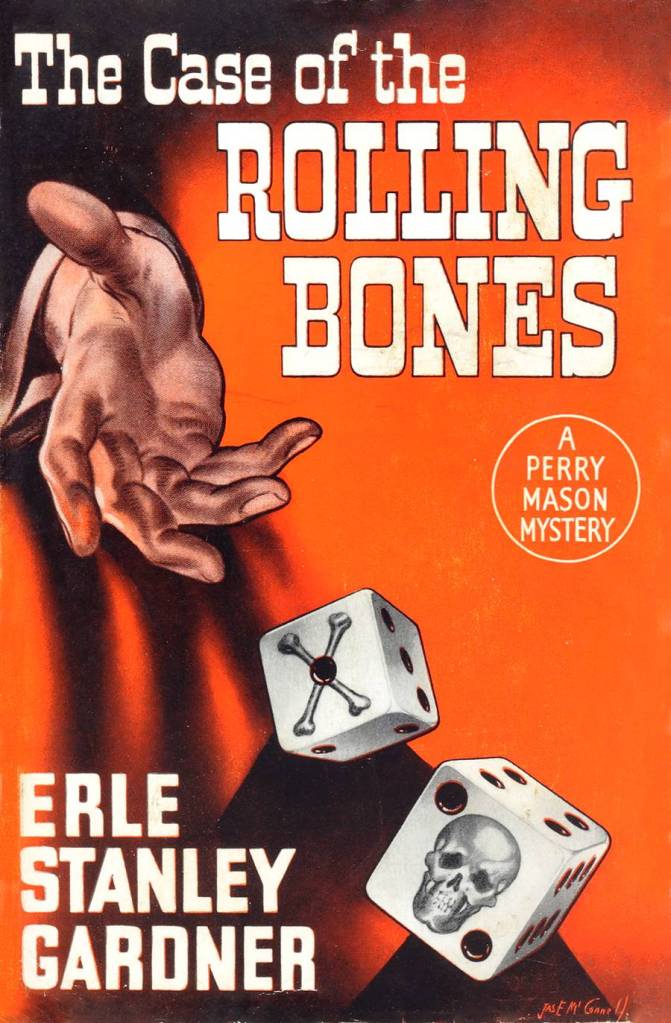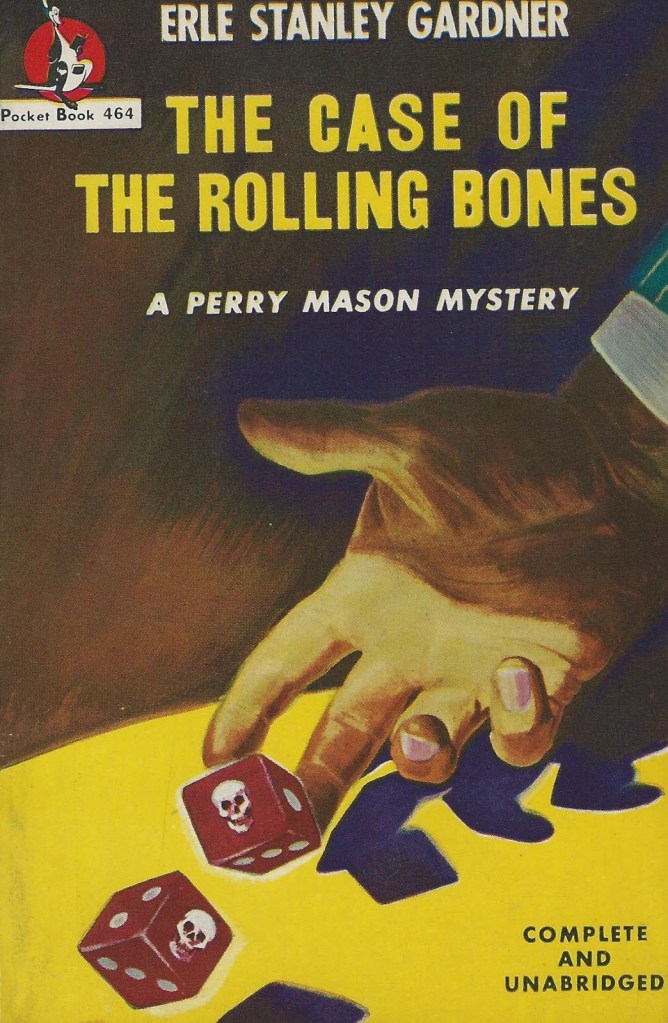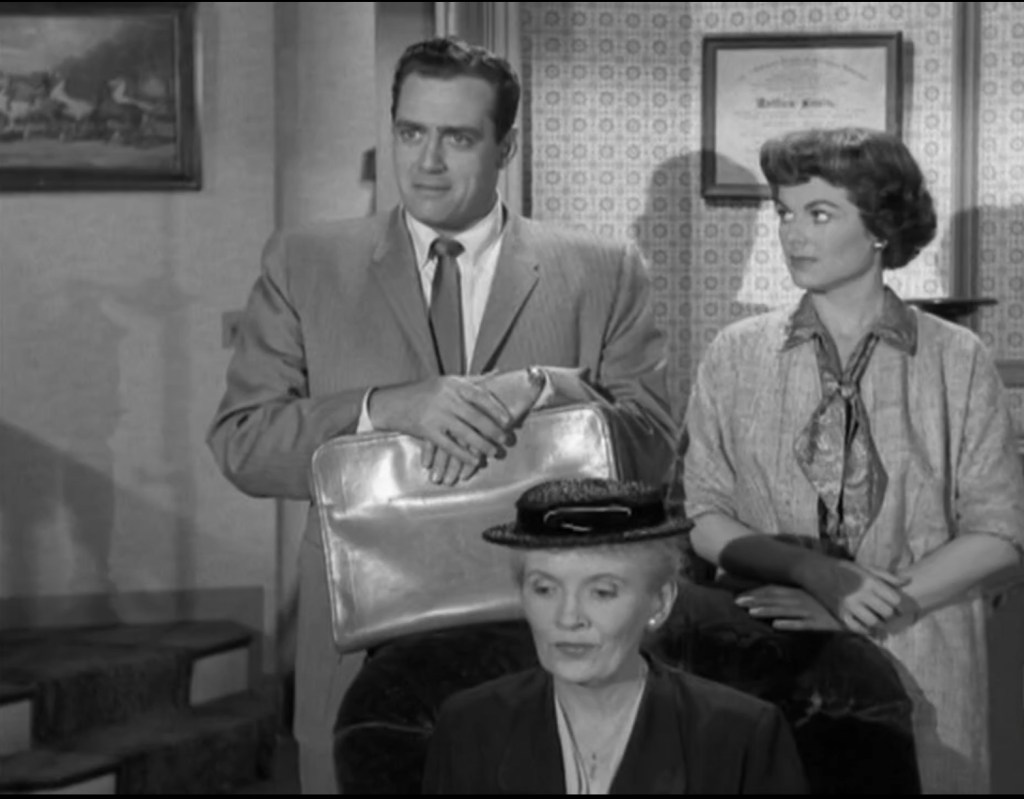“‘Gosh, Della, can’t you scare me up a good mystery?’ Della Street said, ‘I’ve handled all the routine mail. This is the important stuff which needs your personal attention.’ Mason pushed the mail to one side. ‘Shucks, Della, I hate letters. Letters are inanimate. I like people. People are animate. I like to puzzle with human problems.’”
That’s Perry Mason for you, always hungry for more! More troubled clients, more knotty problems – oh, let’s face it – more murders, just like mystery readers all over the world, especially those who, like me, love author Erle Stanley Gardner. And no current publisher recognizes this more than Otto Penzler who, for the past several years, has annually included at least one Gardner title in his American Mystery Classics series. This year, he has come through again with 1939’s The Case of the Rolling Bones, and I’m thrilled to make this my first nomination for this year’s Reprint of the Year, now commencing over at Kate’s place, Cross-Examining Crime. (Click here to find details on how you can get involved!)
Generally speaking, the Perry Mason novels of the 1930’s and ‘40’s are the strongest, and Rolling Bones has a lot going for it. First of all, there is Mason himself: here he is young and energetic, outpacing the Restless Redhead, out-puzzling the Curious Bride, and out-risking the Daring Divorcee! The version of the attorney we find in the novels will stop at nothing – no dirty trick, no stretching or skirting of the law – to do his client a service. And the D.A.’s office – who in Mason’s world plays just as dirty – is always out to get our hero disbarred for this or that legal shenanigans. And in Rolling Bones, Mason finally has it out with both the D.A. du jour, a by-the-book creep named Kittering, and the judge.
“It’s about time the courts realized that they’re agencies for the administration of justice. They’re instruments of the people. They’re here, not to unwind red tape, but to administer justice.”
The legal shenanigans fly fast and furious on both sides in this case. Della Street and P.I. Paul Drake are both on Perry side, and aiding and abetting them is a new, bonus character . . . but more about that later! At the start, Mason’s yearning for human problems is about to be satisfied by the folks waiting in his outer office. Phyllis Leeds is worried about her elderly Uncle Aldin, who has led a storied life, including a stint mining for gold in the Klondike that netted him a fortune. Now the 72-year-old bachelor has declared his love for Emily Milicant, and Aldin’s relatives are steamed up about it. Phyllis is worried that they’re going to do something drastic to stop Emily from getting her clutches on the family fortune; plus, she fears that her uncle is being blackmailed over another matter entirely!
Perry sets Paul Drake out to gather information, but even the quick-thinking detective can’t work fast enough to prevent Aldin’s nephew from taking him out for a lovely drive and committing him to a sanitarium. Can the brilliant defense attorney rescue Mr. Leeds from his greedy relations, figure out who is siphoning checks from the old tycoon and why, andrescue his client from the inevitable murder charge?
Well, of course he can – and he will! There’s never any suspense over whether Mason will succeed. (In fact, at the end, both the D.A. and the judge question Mason over what would happen should he ever defend a client who was guilty. Mason’s response? “He won’t be guilty until they prove him guilty.”) The fun comes from watching him at work, both in court and out in the field. Many of the early novels include little to no court time, but here Mason appears before two courts, first to free Aldin Leeds from a fraudulent commitment – a lovely scene where the defense teams up with a sympathetic judge to make mincemeat of the prosecution – and then to defend him on a charge of murder and make a second D.A. look the fool!
In the process, there are lovely extras to enjoy. No one will claim Gardner was a master at characterization, as everyone existed to serve the plot (and keep Mason happy). But the author had a way with a descriptive sketch, and when he wanted, he could quickly sum up a character in a waythat gave the reader an indelible portrait of the kind of person they were:
“Emily Milicant had quite evidently tried to preserve the contours of youth although she was somewhere between forty-five and fifty-five. She had starved her face into submission, but her body was more obstinate . . . Dieting had made her face gaunt, her neck almost scrawny, but the fit of her dress across the hips lacked the smooth symmetry which she had so evidently tried to achieve . . . (She) dropped into a chair and immediately seemed to become thin.”
We are also treated to one of those special moments that Gardner occasionally provided in order to mercilessly tease we Perry/Della shippers about their relationship. At one point, the pair find themselves waiting at a love nest for a suspect to arrive, and in the early morning hours, Perry gets mischievous.
“Perry Mason‘s hand unconsciously sought Della Street’s, gently imprisoned the fingers. ‘Gosh, Della,’ he said, ‘I’m getting sentimental. It almost seems as though this place has been made for us.’
“She moved her other hand to gently stroke the back of his well-shaped, strong fingers. ‘Nix on it, Chief,’ she said gently. ‘You could no more live a domestic life than you could fly. You’re a freelance, happy-go-lucky, carefree, two-fisted fighter. You might like a home for about two weeks, and then it would bore you stiff. At the end of four months, you’d feel it was a prison.’
“’Well,’ said Mason, ‘this is part of the first two weeks.’”
Finally, there’s that bonus character I promised you. Perry gets himself into one of those frequent scrapes with the police that is going to require a team effort to get out of. Paul Drake is out of range, and Della is limited as to what she can do. The burden falls on a new employee at the lawyer’s office, a switchboard girl named Gertrude Lade . . .
That’s right! Rolling Bones marks the debut appearance of Gertie, the receptionist. All of us fans of the TV show Perry Mason are, of course, aware of Gertie through her portrayal by Bette Davis-lookalike Connie Cezon, whose credits before the series included being hit with a pie by the Three Stooges. Cezon appeared in only seventeen episodes of PM, but her enormous eyes and squeaky voice made her a memorable addition to the show.
All these extras add to the fun of another enjoyable reading experience. I’ll admit the plot here gets a little convoluted. It involves a crime in the past, and the backstory changes at least three times and never seems to settle. There are several characters sharing the same alias (or having three aliases of their own), and one too many of the people on this very long list are extraneous. In the end, though, the case amounts to a simple problem which I basically solved due to my extreme fondness of . . . well, here’s the thing: the title of this novel has a very clever double meaning which you won’t catch until the end!
“The Case of the Rolling Bones” was the 39th and final episode of the first season of Perry Mason. Sadly, Gertie isn’t present, except offscreen at the reception desk. I knew while reading the book that there was no way that a 52-minute-long program could copy this demanding plotline, and it has been seriously trimmed of characters and twists. At least the trial over Aldin Leeds’ forced commitment is left intact, but the murderer in the book, along with their motive, is excised from the episode!! It was therefore up to me to solve the TV version of the case. SPOILER: this was an easy task because the television show traded more in character “types” than the book ever did. The killer here had the exact same personality and motive as the killer in the series debut, “The Case of the Restless Redhead;” that character even recites nearly the same confession speech on the witness stand!
Face it – the book is always better! And now you can own a spiffy new copy courtesy of American Mystery Classics. Please consider voting for The Case of the Rolling Bones as Reprint of the Year! But you can’t vote yet!! You have plenty of time to consider all the options – including the incredible nominee I’m making next week!






Well done Brad!
John
<
div dir=”ltr”>
<
blockquote type=”cite”>
LikeLike
This one sounds great. I went to the big pile and found that I own a copy, which I bought along with a few other Mason paperbacks at a second hand bookshop awhile back. I look forward to reading it.
LikeLiked by 1 person
After the excitement of finding out about the reprint, I looked and discovered that I, too, had an old and lovely paperback copy on my pile of TBR Perry Masons! I hope you enjoy yours!
LikeLike
Pingback: Reprint of the Year Award 2023: Nomination 1 – crossexaminingcrime
Great review. I always liked this story. Gardner had an interesting ability to describe women as another woman would describe them. He had four secretaries and often simultaneously dictated four different stories. It’s possible he sought advice from them.
Too bad the tv version wasn’t done in two episodes, because it really did omit a lot of central plot points from the book. I agree, the print version is always better.
Merry Christmas!
LikeLiked by 1 person
I do like how the women in Gardner, equal to the men, run the gamut of ability, morality, and intelligence. They are often treated in a misogynistic manner by the men, even those in law and order, and it feels to me that Gardner was sympathetic to the women – even the “bad” girls – in most situations I’ve come across in my reading. The series was far more conforming to the times, and the women on TV were portrayed more like film noir women, as either angelic or evil. There are exceptions, of course, like “The Case of the Lucky Loser,” which, along with its remake, “The Case of the Candy Queen,” are among my favorite episodes.
LikeLiked by 1 person
Donald Lam was a notorious softie when it came to women. He was Gardner’s Sir Galahad.
LikeLiked by 1 person
This one was one of my favorite Perry Masons when I read a bunch of them in my teens, not for the convoluted plot (I’m not sure if I ever managed to make sense of the backstory) but for the wonderful drama in both of Masons’s courtroom performances. Also, I always thought that the trick behind the murder is similar to the solution of one of the early Poirot short stories (gur vgnyvna aboyrzna, jurer nyfb gur nccnerag ynfg zrny bs gur ivpgvz jnf npghnyyl snxrq bhg ol uvf xvyyre)
LikeLiked by 1 person
As I haven’t located any of the Mason short works except for The Case of the Crimson Kiss, I won’t decode your message just yet. You can be sure there will be a lot more Gardner in this space in the future!
LikeLike
You misread my comment. I mean the solution of The Case of the Rolling Bones is similar to a Poirot short story, not a Mason story. Apologies for any confusion!
LikeLiked by 1 person
I’m looking forward to reading this one. I had never read any Gardner before engaging with the AMC series. So interesting that such a famous character had fallen out of print.
LikeLiked by 1 person
I agree! Perry Mason was brought to life in the movies, on the radio, and for decades on TV. This nearly always extends the longevity of a character, although it didn’t work for Ellery Queen. The Mysterious Press released several titles in conjunction with the recent HBO series, and now they seem to average around one title a year as part of their American Mystery Classics. I grew up with shelf after shelf of titles to be found in the bookstores, and it’s hard to see the availability and/or demand for them ebb this way.
LikeLike